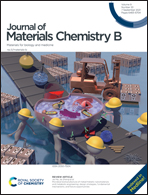Synthesis of Au@MOF core–shell hybrids for enhanced photodynamic/photothermal therapy†
Abstract
Photodynamic/photothermal therapy (PDT/PTT) has become a research focus of cancer treatment due to the non-invasiveness, spatio-temporal controllability, and effectiveness of repeated treatment. Here, Au@MOF core–shell hybrids were designed and constructed by the layer-by-layer method, and the thickness of the MOF shell can be adjusted by controlling the coordination reaction between the layers. Au nanorod cores mainly produce the PTT effect due to their strong absorbance at 650 nm. The porphyrin ligand in the MOF shell can convert O2 into 1O2 under light conditions, resulting in a high PDT effect. Moreover, the metal node Fe3O(OAc)6(H2O)3+ cluster of the MOF can catalyze the decomposition of H2O2 into O2 to overcome the hypoxic environment of tumors, which further improves the effect of PDT. The combination of the porphyrin ligand in the MOF structure and Au nanorods has promoted the synergistic effects of PDT/PTT. As expected, the results confirmed that Au@MOF hybrids showed no obvious biotoxicity in both cells and animal experiments, and exhibited good biocompatibility. With the synergistic effects of PDT/PTT, cancer cells could be effectively killed and tumor growth could be inhibited. In addition, the modification of folic acid on the surface of Au@MOF can further enrich the hybrids at the tumor site and enhance the inhibitory effect on tumors. These studies have proved that PDT and PTT can be effectively combined and have greater advantages in enhancing the treatment of tumors.



 Please wait while we load your content...
Please wait while we load your content...